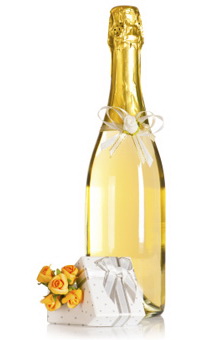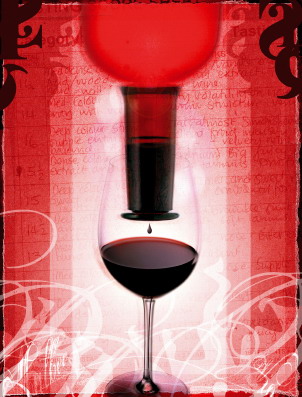 These are big-game bottles. Drink one and you become a character in a Hemingway story.
These are big-game bottles. Drink one and you become a character in a Hemingway story.
We hunted for the bottle under the hot sun. We brought it down. The bottle was big. Drinking it felt good. We drank until the bottle was empty, and then we fell asleep.
Known in the trade as large formats, big wine bottles are larger animals than the standard 750 ml. They range in size from the magnum, which equals two standard bottles (1.5 litres), to the nebuchadnezzar (neb-kd-NE-zr), which equals 20 standard bottles and weighs in at a table-warping 15 litres.
According to a wine industry survey, 69% of respondents said they own big wine bottles, and 63% said they wish they owned more.
Big bottles first made their appearance about 2,000 years ago when the Romans developed glass-blowing. Before that, wine was stored in large clay amphorae.
Since glass did not affect the taste of the wine as clay did, it became the preferred storage material. And since glass bottles were made to imitate the clay amphorae, the first bottles were large. 
Many names applied to large bottles belie their biblical lineage: Nebuchadnezzar, for instance, was the king who built Babylon and conquered Jerusalem.
Balthazar was one of the three kings bearing gifts for the newborn Jesus. Rehoboam was King Solomon’s eldest son. Methuselah was the oldest man who ever lived; and Jeroboam formed the northern kingdom of Israel with the ten tribes.
Over the millennia, sizes became smaller – eventually ranging between 600 and 800 ml. These were easiest to carry and to make — glassblowers needed only one breath to create this size.
Millions of bottles later, in 1979, 750 ml became standard when the U.S. promoted the metric system.
Today, vinous safari hunters prize large bottles not only because of their novelty size and rarity, but also because they believe that the wine ages more slowly, and therefore, more gracefully.
The theory is that the small volume-to-surface ratio reduces oxidation. Actually, there’s little documented evidence for this.
The oxygen at the head of bottled wine gets absorbed into the wine during first week after bottling; after that, only an insignificant one-tenth of a cubic centimeter gets past the cork each year.
Other collectors believe that since big bottles heat up and cool down more slowly than standard bottles, they’re less susceptible to damaging temperature fluctuations.
“We’re seeing a surge of interest in large bottles as cellar showpieces, for home entertaining, and as restaurant displays,” says Ian Mendelsohn, wine specialist at Christie’s auction house in New York.
At recent auctions, hammer prices exceeded the estimated prices by magnum-size margins. A methuselah 1985 Romanée-Conti, DRC fetched $51,750, although the estimated range was between $25,000-$35,000.
 A jeroboam 1982 Mouton Rothschild went for $5,750 rather than $3200-$4500; and an imperial 1961 Latour, estimated at $10,000-$15,000, for $21,850.
A jeroboam 1982 Mouton Rothschild went for $5,750 rather than $3200-$4500; and an imperial 1961 Latour, estimated at $10,000-$15,000, for $21,850.
Many vintners use large bottles to showcase good vintages, to mark the winery’s commemorative years or for charitable purposes.
Inniskillin Wines in Ontario bottles icewine in a magnum (four times the standard half-bottle size for icewine) for fundraising auctions. Since this size can’t be bought at retail, it’s coveted by bidders: one bottle recently sold for $1,500.
In 1998, the New York auctioneers Morrell & Co. sold a four-foot bottle of port, containing 98 liters for US$24,150.
The producer, Fonseca, made the bottle in 1982 to raise awareness and funds for a rare genetic disease prevalent just north of Oporto, the city in which the port is produced.
After many unsuccessful attempts to create a large enough mold, the glassblowers finally used one made in the hollowed-out trunk of a 500-year-old tree.
However, the world’s largest bottle has never been in an auction room. To celebrate the new millennium in New York’s Times Square, California winery Korbel Champagne Cellars produced a five-foot, 372-pound bottle of sparkling wine.
The Guinness Book of Records has certified it as the world’s largest, with the equivalent of 160 standard bottles — and eight billion bubbles. It is now on display — or can’t be budged from – at the Korbel winery.
For consumers, though, big bottles are festive for holidays, weddings, anniversaries, graduations, birthdays and even barbecues.
They make a visual splash that tells your guests they’re worth more than the standard plonk. And like big cars, big houses and big yachts, they announce big bucks when the message is you’re worth more, and so am I.
Yet big bottles represent only 5% of wine purchased at the LCBO. Perhaps a little big goes a long way. Granted, big bottles are difficult to store, since they don’t fit traditional wine racks.
They can also be awkward to open and serve — unless you own a forklift. Perhaps the greatest deterrent, though, is the perceived need for a special occasion or a large group to open one.
But a magnum feels reassuringly temperate, even for everyday drinking. After you’ve polished off half, you still have a standard size bottle left.
No need to play leveling games, eying your friends’ glasses to make sure you’re even. There’s plenty to go around so everyone can act generous.
Here are my recent ratings and reviews for magnum bottles of wine.
Size Chart: Measuring Up
Half Bottle: 375 ml — ½ bottle
Standard Bottle: 750 ml — 1 bottle
Magnum: 1.5 litres — 2 bottles
Marie-Jeanne: 2.5 litres –3 bottles
Double Magnum: 3 litres — 4 bottles
Jeroboam (sparkling): 3 litres — 4 bottles
Jeroboam (still): 4.5 litres — 6 bottles
Reboboam: 4.5 litres — 6 bottles
Imperial: 6 litres — 8 bottles
Methuselah: 6 litres — 8 bottles
Salmanazar: 9 litres — 12 bottles
Balthazar: 12 litres — 16 bottles
Nebuchadnezzar: 15 litres — 20 bottles







